Biodiversity and Sediment Contamination in Wet Stormwater Ponds Depending on Design and Catchment Characteristics
Abstract
:1. Introduction
- The most common type of ponds in the study area is expected to be wet ponds with high age and a low ratio between wet volume and reduced catchment area as ponds have been used as a BAT method in Denmark for decades. In addition, the most prevalent catchment areas are expected to be urban and urban mixed with industrial areas because the examined ponds are placed in Odense Municipality, Denmark.
- Increased ratio between the wet volume and reduced catchment area is expected to be linked to lower nutrient and metal contents due to lower area specific loading. This is also expected to have a positive effect on the biodiversity and animal composition due to more niches being available and lower hydrological stress.
- It is expected that retention decreases with age due to accumulation in the pond and, thus, higher nutrient and metal contents. Thus, the biodiversity is not expected to increase with pond age.
- It is expected that the catchment types most affected by human activities will cause the highest load of metals and nutrients, resulting in comparable low biodiversity.
- The content of contaminants and biodiversity in the inlet and outlet areas of the ponds are expected to be different from one another. Possibly these differences will be correlated to variations in age, land use and ratio.
2. Materials and Methods
2.1. Study Area
2.2. GIS Analysis
2.3. Sampling Water and Sediment
2.4. Biodiversity
2.5. Diversity Indexes and Animal Designation
2.6. Statistics
3. Results
3.1. A summary of Pond Characteristics
3.2. The 12 Experimental Ponds
3.2.1. DW, OM and TP
Catchment Classification
Effect of Pond Volume Versus Impermeable Catchment Area
Impact of Pond Age
3.2.2. Metals
Effect on Metal Content by Catchment Type
Ratio Impact on Metals Contents
Impact of Pond Age on Metals Content
3.2.3. Biodiversity
Water Phase
Sediment
Distribution of Species in Water Phase
Correlations between Biodiversity and Ratio, Age, DW, Organic Content, TP and Metals
4. Discussion
4.1. Summary of Pond Characteristics
4.2. Experimental Ponds
4.2.1. Catchment Types
4.2.2. Ratio and Age
4.3. Biodiversity
4.3.1. Impact of Ratio and Age on Biodiversity in Water Phase and Sediment
4.3.2. Invertebrate Distribution
5. Conclusions
Author Contributions
Funding
Institutional Review Board Statement
Informed Consent Statement
Data Availability Statement
Acknowledgments
Conflicts of Interest
References
- McDonald, R.I.; Marcotullio, P.J.; Güneralp, B. Urbanization and global trends in biodiversity and ecosystem services. In Urbanization, Biodiversity and Ecosystem Services: Challenges and Opportunities; Springer: Dordrecht, The Netherlands, 2013; pp. 31–52. [Google Scholar]
- Gabriel, S.; Larsen, T.H.; Vollertsen, J. Baggrundsnotat: BAT-Lokale Nedsivnings- og Renseløsninger (Backgroundnote: BAT-Local Infiltration and Cleansing Solutions); Aalborg University, Teknologisk Institut: Aalborg, Denmark, 2012; Volume 1, pp. 1–71. [Google Scholar]
- Vollertsen, J.; Hvitved-Jacobsen, T.; Nielsen, A.H.; Gabriel, S. Våde Bassiner til Rensning af Separat Regnvand (Wet Ponds for Cleaning Separate Stormwater); Aalborg University, Teknologisk Institut: Aalborg, Denmark, 2012; Volume 1, pp. 1–71. [Google Scholar]
- DANVA. Designguide for regnvandsbassiner (Designmanual for stormwaterponds). DANVA Guides 2018, 1, 12–17. [Google Scholar]
- The Danish Environmental Protection Agency. BAT-Eksempler og Tjeklister på Tværs af Brancher (BAT-Examples and Checklist across Industries); The Danish Environmental Protection Agency: Copenhagen, Denmark, 2014; p. 61. [Google Scholar]
- Shammaa, Y.; Zhu, D.Z. Techniques for controlling total suspended solids in stormwater runoff. Can. Water Resour. J. 2001, 26, 359–375. [Google Scholar] [CrossRef]
- Scher, O.; Chavaren, P.; Despreaux, M.; Thiéry, A. Highway stormwater detention ponds as biodiversity islands? Arch. Sci. 2004, 57, 121–130. [Google Scholar]
- Vollertsen, J.; Nielsen, A.H.; Rasmussen, M.R.; Hvitved-Jacobsen, T. Wet stormwaterponds. Mikroben 2006, 14, 4–9. [Google Scholar]
- McKenzie, E.R.; Wong, C.M.; Green, P.G.; Kayhanian, M.; Young, T.M. Size dependent elemental composition of road-associated particles. Sci. Total. Environ. 2008, 398, 145–153. [Google Scholar] [CrossRef] [Green Version]
- Kayhanian, M.; McKenzie, E.; Leatherbarrow, J.; Young, T. Characteristics of road sediment fractionated particles captured from paved surfaces, surface run-off and detention basins. Sci. Total. Environ. 2012, 439, 172–186. [Google Scholar] [CrossRef]
- Egemose, S.; Jensen, H.S. Phosphorus forms in urban and agricultural runoff: Implications for management of Danish Lake Nordborg. Lake Reserv. Manag. 2009, 25, 410–418. [Google Scholar] [CrossRef] [Green Version]
- Stone, M.; English, M. Geochemistry, phosphorus speciation and mass transport of sediment grain size fractions (<63/* m) in two Lake Erie tributaries. Hydrobiologia 1993, 253, 17–29. [Google Scholar]
- Barbosa, A.E.; Hvitved-Jacobsen, T. Infiltration pond design for highway runoff treatment in semiarid climates. J. Environ. Eng. 2001, 127, 1014–1022. [Google Scholar] [CrossRef]
- Sand-Jensen, K. Ferskvandsøkologi (Freshwaterecology); Gyldendal A/S: Copenhagen, Denmark, 2004. [Google Scholar]
- Jensen, H.S.; Kristensen, P.; Jeppesen, E.; Skytthe, A. Iron: Phosphorus ratio in surface sediment as an indicator of phosphate release from aerobic sediments in shallow lakes. In Sediment/Water Interactions; Springer: Dordrecht, Holland, 1992; pp. 731–743. [Google Scholar]
- Hvitved-Jacobsen, T.; Johansen, N.; Yousef, Y. Treatment systems for urban and highway run-off in Denmark. Sci. Total. Environ. 1994, 146, 499–506. [Google Scholar] [CrossRef]
- Yousef, Y.; Wanielista, M.; Hvitved-Jacobsen, T.; Harper, H. Fate of heavy metals in stormwater runoff from highway bridges. Sci. Total. Environ. 1984, 33, 233–244. [Google Scholar] [CrossRef]
- Sønderup, M.J.; Egemose, S.; Hansen, A.S.; Grudinina, A.; Madsen, M.H.; Flindt, M.R. Factors affecting retention of nutrients and organic matter in stormwater ponds. Ecohydrology 2016, 9, 796–806. [Google Scholar] [CrossRef] [Green Version]
- Egemose, S.; Sønderup, M.J.; Grudinina, A.; Hansen, A.S.; Flindt, M.R. Heavy metal composition in stormwater and retention in ponds dependent on pond age, design and catchment type. Environ. Technol. 2015, 36, 959–969. [Google Scholar] [CrossRef]
- Hvitved-Jacobsen, T.; Vollertsen, J.; Nielsen, A.H. Urban and Highway Stormwater Pollution: Concepts and Engineering; CRC Press: Boca Raton, FL, USA, 2010. [Google Scholar]
- Göbel, P.; Dierkes, C.; Coldewey, W. Storm water runoff concentration matrix for urban areas. J. Contam. Hydrol. 2007, 91, 26–42. [Google Scholar] [CrossRef]
- Campbell, K. Concentrations of heavy metals associated with urban runoff in fish living in stormwater treatment ponds. Arch. Environ. Contam. Toxicol. 1994, 27, 352–356. [Google Scholar] [CrossRef]
- Stephansen, D.A.; Nielsen, A.H.; Hvitved-Jacobsen, T.; Arias, C.A.; Brix, H.; Vollertsen, J. Distribution of metals in fauna, flora and sediments of wet detention ponds and natural shallow lakes. Ecol. Eng. 2014, 66, 43–51. [Google Scholar] [CrossRef]
- Le Viol, I.; Mocq, J.; Julliard, R.; Kerbiriou, C. The contribution of motorway stormwater retention ponds to the biodiversity of aquatic macroinvertebrates. Biol. Conserv. 2009, 142, 3163–3171. [Google Scholar] [CrossRef]
- Briers, R.A. Invertebrate communities and environmental conditions in a series of urban drainage ponds in Eastern Scotland: Implications for biodiversity and conservation value of SUDS. Clean Soil Air Water 2014, 42, 193–200. [Google Scholar] [CrossRef] [Green Version]
- Stephansen, D.A.; Nielsen, A.H.; Hvitved-Jacobsen, T.; Pedersen, M.L.; Vollertsen, J. Invertebrates in stormwater wet detention ponds—Sediment accumulation and bioaccumulation of heavy metals have no effect on biodiversity and community structure. Sci. Total. Environ. 2016, 566, 1579–1587. [Google Scholar] [CrossRef]
- Sibanda, T.; Selvarajan, R.; Tekere, M. Urban effluent discharges as causes of public and environmental health concerns in South Africa’s aquatic milieu. Environ. Sci. Pollut. Res. 2015, 22, 18301–18317. [Google Scholar] [CrossRef] [PubMed]
- Meyer, J.L.; Paul, M.J.; Taulbee, W.K. Stream ecosystem function in urbanizing landscapes. J. North Am. Benthol. Soc. 2005, 24, 602–612. [Google Scholar] [CrossRef]
- Walsh, C.J.; Roy, A.H.; Feminella, J.W.; Cottingham, P.D.; Groffman, P.M.; Morgan, R.P. The urban stream syndrome: Current knowledge and the search for a cure. J. North Am. Benthol. Soc. 2005, 24, 706–723. [Google Scholar] [CrossRef]
- Koziel, L.; Juhl, M.; Egemose, S. Effects on biodiversity, physical conditions and sediment in streams receiving stormwater discharge treated and delayed in wet ponds. Limnologica 2019, 75, 11–18. [Google Scholar] [CrossRef]
- Narangarvuu, D.; Hsu, C.-B.; Shieh, S.-H.; Wu, F.-C.; Yang, P.-S. Macroinvertebrate assemblage patterns as indicators of water quality in the Xindian watershed, Taiwan. J. Asia-Pac. Entomol. 2014, 17, 505–513. [Google Scholar] [CrossRef]
- Søndergaard, M.; Lauridsen, T.L.; Kristensen, E.A.; Baattrup-Pedersen, A.; Wiberg-Larsen, P.; Bjerring, R.; Friberg, N. Biologiske Indikatorer i Danske Vandløb og søer-Vurdering af Økologisk Kvalitet (Biological Indicators in Danish Stream and Lakes-Evaluation of Ecological Quality); Aarhus University, DCE–National Center for Environment and Energy: Roskilde, Denmark, 2013; Available online: http://www.dmu/Pub/SR59.pdf (accessed on 23 September 2021).
- Dall, P.C.; Lindgaard, C. En Oversigt over Danske Ferskvandsinvertebrater til Brug ved Bedømmelse af Forureningen i søer og Vandløb (an Overview of Danish Freshwaterinvertebrates for Use in Assesement of Pollution in Lakes and Streams); Ferskvandsbiologisk Laboratorium: Hillerød, Denmark, 1995. [Google Scholar]
- Nath, B.B. Extracellular hemoglobin and environmental stress tolerance in Chironomus larvae. J. Limnol. 2018, 77. [Google Scholar] [CrossRef] [Green Version]
- Odense Municipality. Odense i tal 2020 (Odense in numbers 2020). In Odense Kommune, Borgmesterforvaltningen, Økonomi og Digitalisering; Odense Municipality: Odense, Denmark, 2020; p. 4. Available online: https://www.odense.dk/om-kommune/statistikker-og-regnskaber/odense-i-tal/odense-i-tal (accessed on 17 February 2021).
- The Danish Agency for Data Supply and Efficiency. GeoDanmark Ortofoto (Blocks). Available online: https://download.kortforsyningen.dk/content/geodanmark-ortofoto-blokinddelt (accessed on 28 November 2019).
- Odense Municipality. Spildevandsplan 2011–2022 (Wastewater Management Plan 2011–2022); Odense Municipality: Odense, Denmark, 2011; p. 12. Available online: https://www.odense.dk/borger/miljoe-og-affald/spildevand-og-regnvand/spildevandsplanen (accessed on 3 March 2021).
- Koroleff, F. Determination of phosphorus. In Methods Seawater Analyses, 2nd ed.; Grasshoff, K., Kremling, K., Ehrhardt, M., Eds.; Verlag Chemie: Weinheim, Germany, 1983. [Google Scholar]
- Danish Environmental Agency. Biologisk bedømmelse af vandløbskvalitet (Biological assesment of streamquality). Guide 1998, 5, 1–42. [Google Scholar]
- Bruun, H.H. Are the insects disappearing? Relev. Nat. 2019, 2019, 8–12. [Google Scholar]
- Waage, B.R.E. Trapping efficiency of carabid beetles in glass and plastic pitfall traps containing different solutions. Fauna Nor. Ser. B 1985, 32, 33–36. [Google Scholar]
- Sand-Jensen, K.; Bekkevold, D.; Christoffersen, K.S.; Hansen, M.M.; Lindgaard, C.; Nielsen, E.E.; Sivebæk, F.; Skov, C. Naturen i Danmark De Ferske Vande (Nature in Denmark The Fresh Waters), bd. 5; Gyldendal A/S: Copenhagen, Denmark, 2013; Volume 5, p. 504. [Google Scholar]
- Smith, B.; Wilson, J.B. A consumer’s guide to evenness indices. Oikos 1996, 76, 70–82. [Google Scholar] [CrossRef]
- Pielou, E.C. Ecological Diversity; John Wiley and Sons: New York, NY, USA, 1975. [Google Scholar]
- Boutrup, S.F.P.; Thomsen, M.; Dahlöff, I.; Larsen, M.M.; Strand, J.; Sortkjær, O.; Ellermann, T.; Rasmussen, P.; Jørgensen, L.F.; Pedersen, M.W.; et al. Miljøfremmede Stoffer og Tungmetaller i Vandmiljøet. Tilstand og Udvikling, 1998-2003. Danmarks Miljøundersøgelser. (Pollutants and Heavy Metals in the Aquatic Environment. Condition and Development, 1998–2003. Denmark’s Environmental Surveys.); Miljøstyrelsen (Danish Environmental Protection Agency) Miljøministeriet (Ministry of the Environment): Copenhagen, Denmark, 2006; 140p. [Google Scholar]
- Realdania & Sustainia. 100 Klimaløsninger fra de Danske Kommuner (100 Clima Solutions from the Danish Municipalities); Realdania & Sustainia: Copenhagen, Denmark, 2018; p. 119. [Google Scholar]
- Su, T.-M.; Yang, S.-C.; Shih, S.-S.; Lee, H.-Y. Optimal design for hydraulic efficiency performance of free-water-surface constructed wetlands. Ecol. Eng. 2009, 35, 1200–1207. [Google Scholar] [CrossRef]
- Persson, J.; Somes, N.L.; Wong, T. Hydraulics efficiency of constructed wetlands and ponds. Water Sci. Technol. 1999, 40, 291–300. [Google Scholar] [CrossRef]
- Petersen, L. Grundtræk af Jordbundslæren (Outline of Soil Science); Jordbrugsforlaget: Frederiksberg, Denmark, 1994. [Google Scholar]
- Sheller, M. Aluminum Dreams: The Making of Light Modernity; MIT Press: Cambridge, MA, USA, 2014. [Google Scholar]
- Mallin, M.A.; Ensign, S.H.; Wheeler, T.L.; Mayes, D.B. Pollutant removal efficacy of three wet detention ponds. J. Environ. Qual. 2002, 31, 654–660. [Google Scholar] [CrossRef]
- Wakelin, S.A.; Colloff, M.J.; Kookana, R.S. Effect of wastewater treatment plant effluent on microbial function and community structure in the sediment of a freshwater stream with variable seasonal flow. Appl. Environ. Microbiol. 2008, 74, 2659–2668. [Google Scholar] [CrossRef] [Green Version]
- Mlejnková, H.; Sovová, K. Impact of pollution and seasonal changes on microbial community structure in surface water. Water Sci. Technol. 2010, 61, 2787–2795. [Google Scholar] [CrossRef] [PubMed]
- Drury, B.; Rosi-Marshall, E.; Kelly, J.J. Wastewater treatment effluent reduces the abundance and diversity of benthic bacterial communities in urban and suburban rivers. Appl. Environ. Microbiol. 2013, 79, 1897–1905. [Google Scholar] [CrossRef] [Green Version]
- Qin, Y.; Hou, J.; Deng, M.; Liu, Q.; Wu, C.; Ji, Y.; He, X. Bacterial abundance and diversity in pond water supplied with different feeds. Sci. Rep. 2016, 6, 1–13. [Google Scholar] [CrossRef] [PubMed] [Green Version]
- Davies, C.; Bavor, H. The fate of stormwater—Associated bacteria in constructed wetland and water pollution control pond systems. J. Appl. Microbiol. 2000, 89, 349–360. [Google Scholar] [CrossRef] [PubMed] [Green Version]
- Dale, N.G. Bacteria in intertidal sediments: Factors related to their distribution 1. Limnol. Oceanogr. 1974, 19, 509–518. [Google Scholar] [CrossRef]
- Mackintosh, T.J.; Davis, J.A.; Thompson, R.M. The influence of urbanisation on macroinvertebrate biodiversity in constructed stormwater wetlands. Sci. Total. Environ. 2015, 536, 527–537. [Google Scholar] [CrossRef]
- Rawson, C.A.; Lim, R.P.; Tremblay, L.A.; Warne, M.S.J.; Ying, G.-g.; Laginestra, E.; Chapman, J.C. Benthic macroinvertebrate assemblages in remediated wetlands around Sydney, Australia. Ecotoxicology 2010, 19, 1589–1600. [Google Scholar] [CrossRef]
- Sun, Z.; Sokolova, E.; Brittain, J.E.; Saltveit, S.J.; Rauch, S.; Meland, S. Impact of environmental factors on aquatic biodiversity in roadside stormwater ponds. Sci. Rep. 2019, 9, 1–13. [Google Scholar] [CrossRef] [PubMed]
- Golovanova, I.; Frolova, T. Effect of copper, zink and cadmium on carbohydrate activity of aquatic invertebrates. Biol. Vnutr. Vod/Biol. Inland Water 2005, 4, 77–83. [Google Scholar]
- Eisler, R. Copper Hazards to Fish, Wildlife, and Invertebrates: A Synoptic Review; US Department of the Interior, US Geological Survey: Washington, DC, USA, 1998.
- Kopáček, J.; Borovec, J.; Hejzlar, J.; Ulrich, K.-U.; Norton, S.A.; Amirbahman, A. Aluminum control of phosphorus sorption by lake sediments. Environ. Sci. Technol. 2005, 39, 8784–8789. [Google Scholar]
- Blecken, G.-T.; Hunt III, W.F.; Al-Rubaei, A.M.; Viklander, M.; Lord, W.G. Stormwater control measure (SCM) maintenance considerations to ensure designed functionality. Urban Water J. 2017, 14, 278–290. [Google Scholar] [CrossRef] [Green Version]
- Stage Sø, J.; Sand-Jensen, K.; Baastrup-Spohr, L. Temporal development of biodiversity of macrophytes in newly established lakes. Freshw. Biol. 2020, 65, 379–389. [Google Scholar] [CrossRef]
- Møller, M.J.; Sand-Jensen, K.; Kragh, T. Fuglesamfund i spritnye og naturlige søer (Bird societies in brand new and natural lakes). Vand og Jord 2020, 4, 161–165. [Google Scholar]
- Kolath, T.E.S.; Jensen, H.S.; Reitzel, K. Fosforindhold og frigivelse fra sediment i nye og naturlige søer (Phosphoruscontent and release from sediment in new and natural lakes). Vand og jord 2020, 4, 131–135. [Google Scholar]
- Kolath, T.E.S.; Jensen, H.S.; Reitzel, K. Does reestablished and new lakes behave like natural lakes with regards to sediment composition and phosphorus fluxes. In-prep.
- Bryant, D.; Papas, P. Macroinvertebrate Communities in Artificial Wetlands: The Influence of Macrophytes; Arthur Rylah Institute for Environmental Research, Department of Sustainability and Environment: Heidelberg, Australia, 2007. [Google Scholar]
- Learner, M.; Lochhead, G.; Hughes, B. A review of the biology of British Naididae (Oligochaeta) with emphasis on the lotic environment. Freshw. Biol. 1978, 8, 357–375. [Google Scholar] [CrossRef]
- Sinclair, J.S.; Reisinger, L.S.; Adams, C.R.; Bean, E.; Reisinger, A.J.; Iannone, B.V. Vegetation management and benthic macroinvertebrate communities in urban stormwater ponds: Implications for regional biodiversity. Urban Ecosyst. 2021, 24, 725–735. [Google Scholar] [CrossRef]
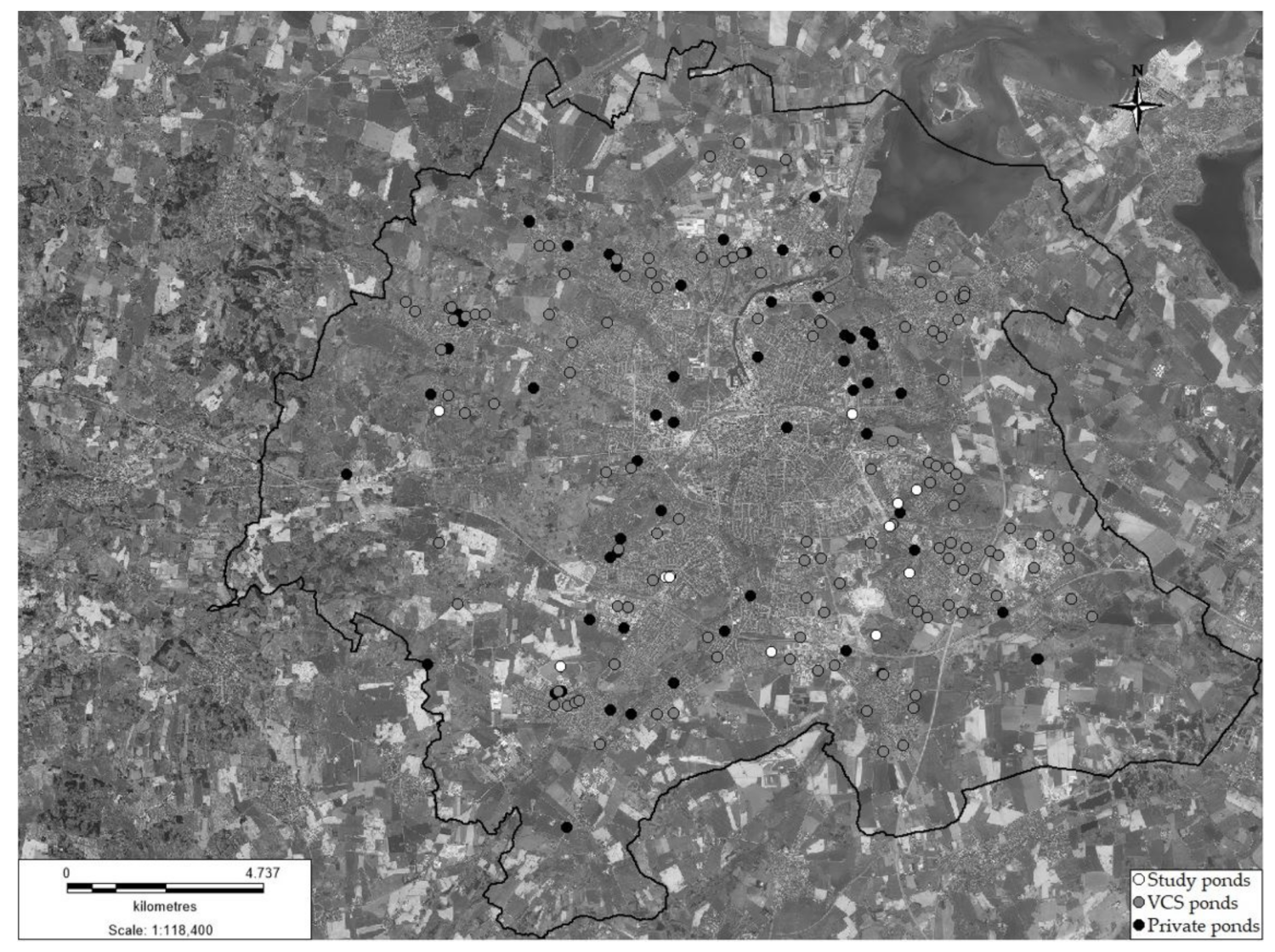
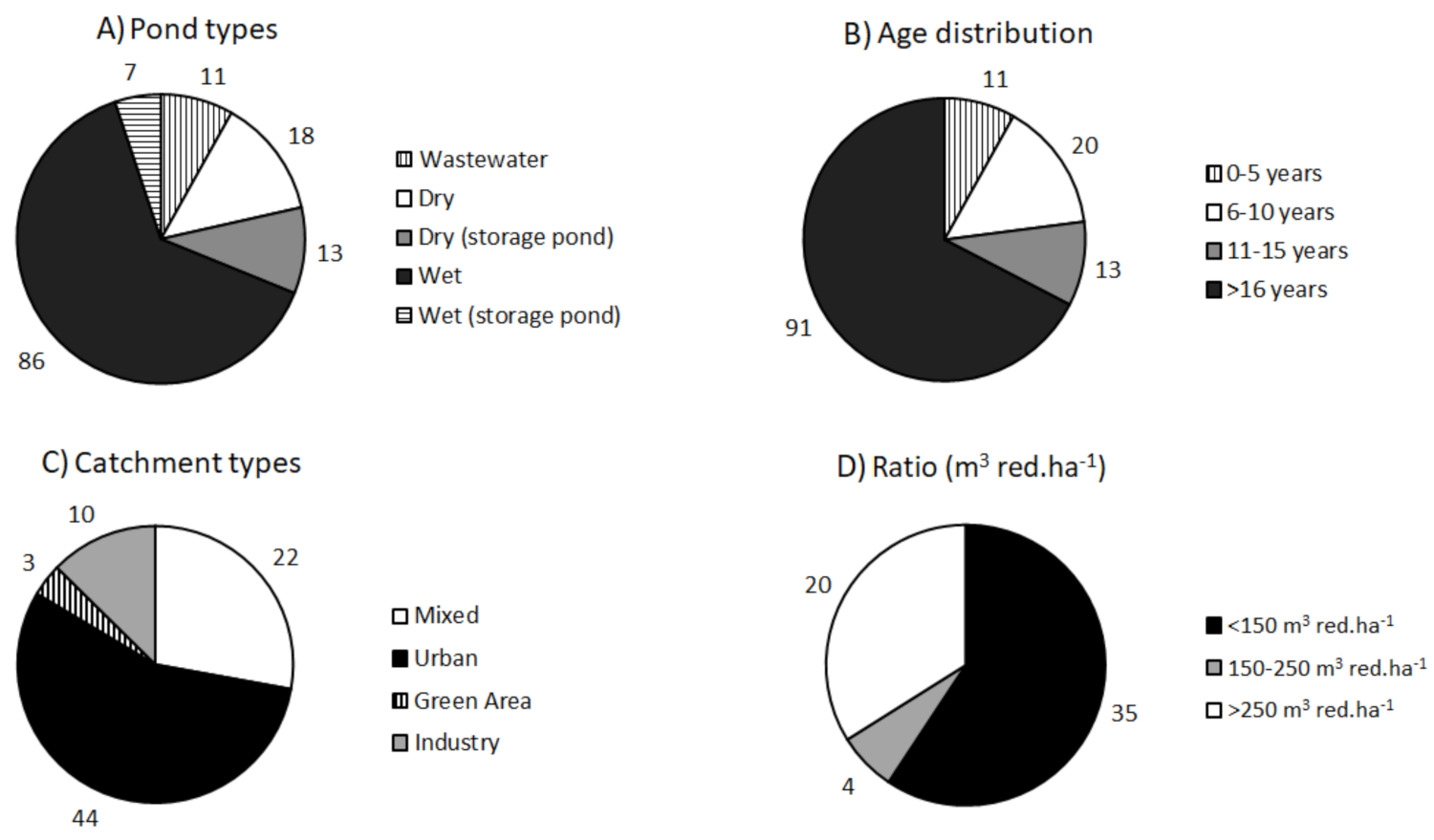
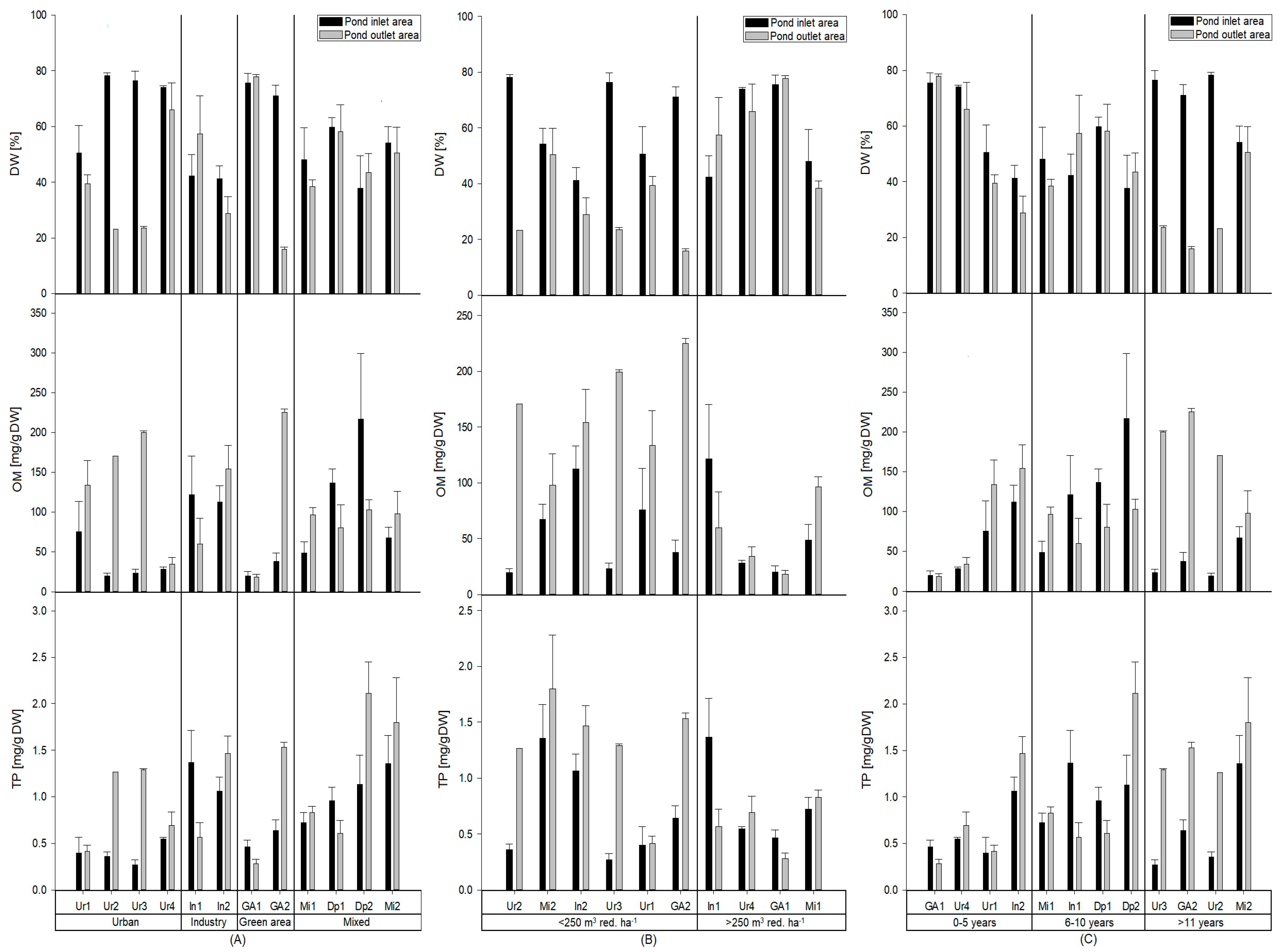


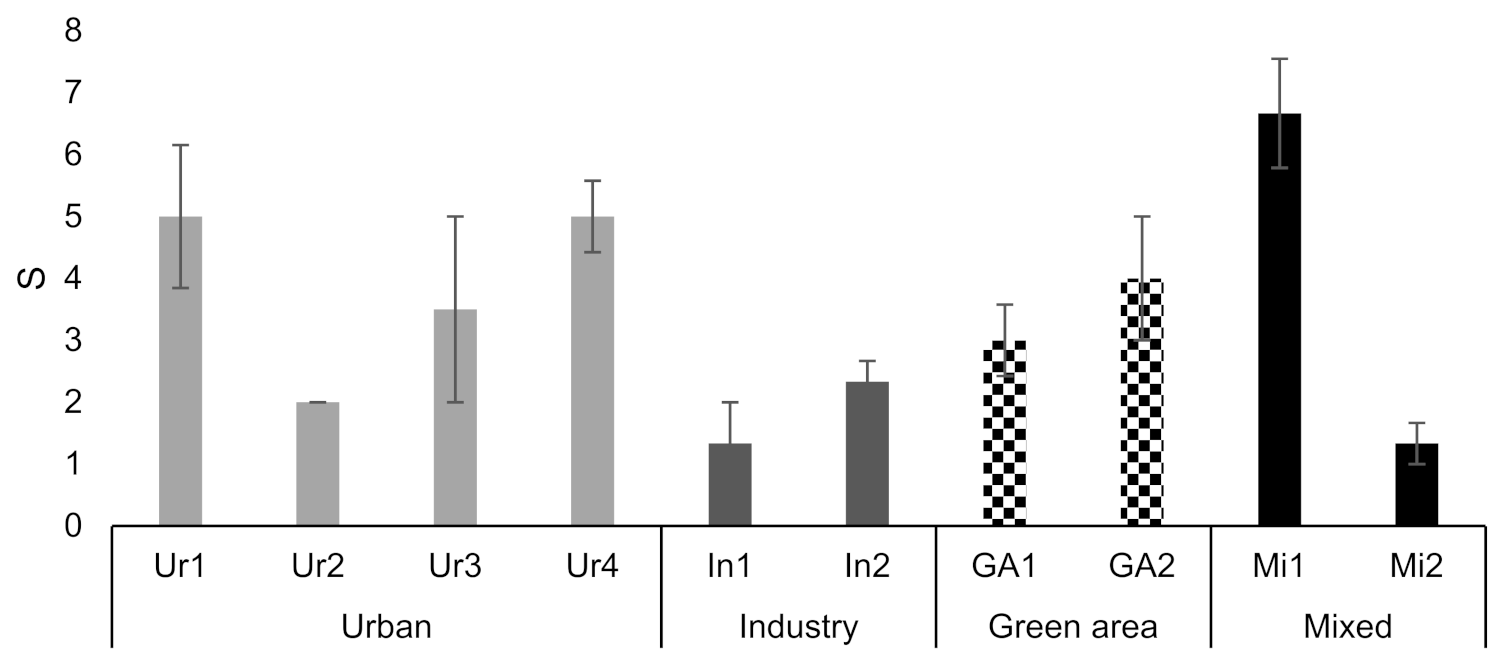
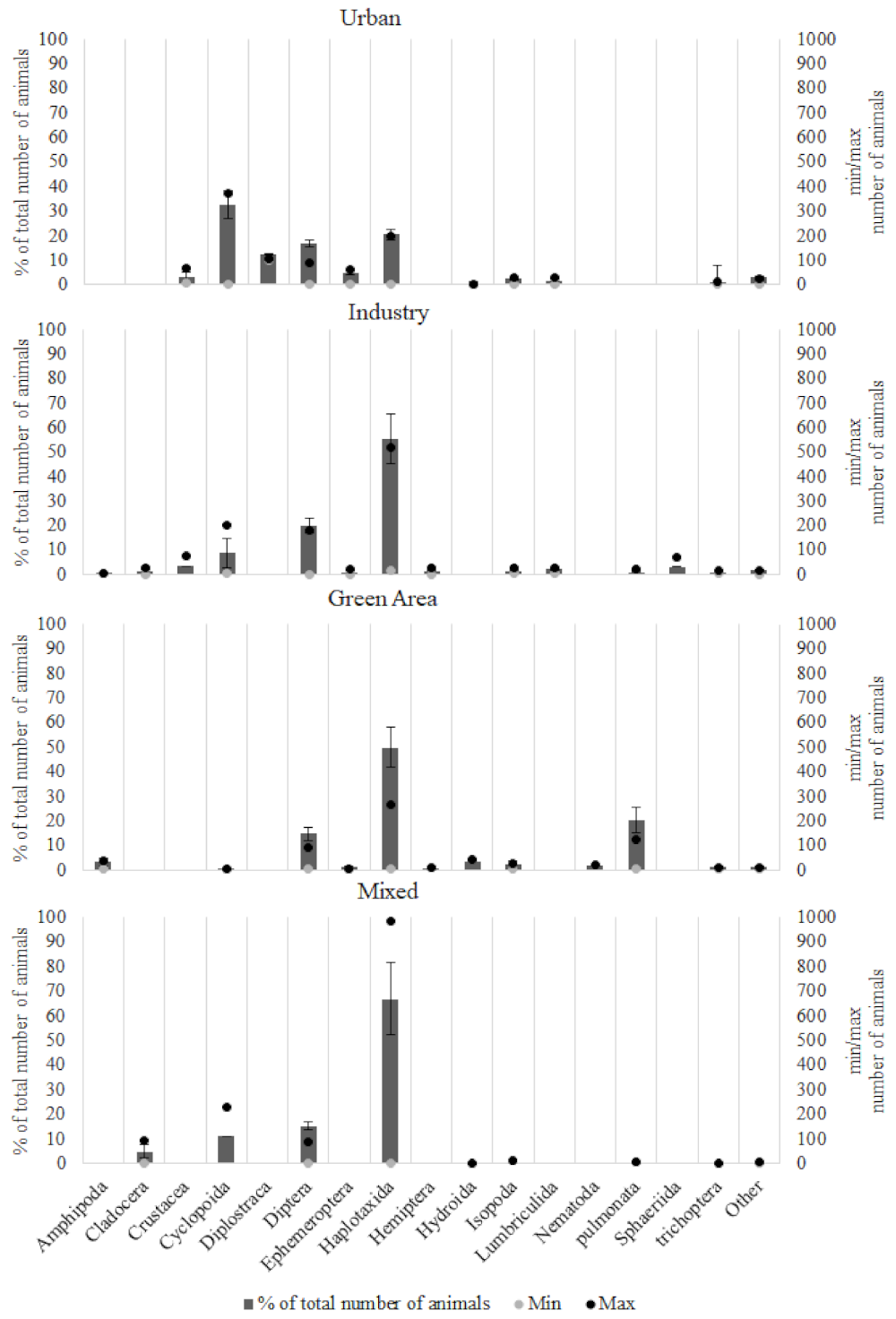
| Summary of Characteristics for All Ponds | |||||||
| Catchment Type | No. | Age (Years) | Water Surface/Bottom Area (m2) | Ratio (m3 red·ha−1) * | Distance from Inlet to Outlet (m) | ||
| Urban | 44 | avg ±SD | 31 ± 15 | 1159 ± 2357 | 361 ± 969 | 49 ± 68 | |
| Range | 2–58 | 10–1156 | 4–5015 | 10–379 | |||
| Industry | 10 | avg ±SD | 27 ± 19 | 1974 ± 1840 | 290 ± 421 | 45 ± 22 | |
| Range | 5–57 | 131–5709 | 18–1286 | 23–81 | |||
| Green area | 3 | avg ±SD | 17 ± 23 | 16,712 ± 25,948 | 2234 ± 1729 | 157 ± 107 | |
| Range | 2–44 | 49–46,609 | 1012–3457 | 81–233 | |||
| Mixed | 22 | avg ±SD | 23 ± 15 | 1618 ± 3693 | 361 ± 738 | 37 ± 27 | |
| Range | 5–54 | 16–17,701 | 30–3062 | 1–85 | |||
| Selected 12 Experimental Ponds | |||||||
| Catchment Type | No. | Age (Years) | Water Surface/Bottom Area (m2) | Volume (m3) | Ratio (m3 red·ha−1) * | Distance from Inlet to Outlet (m) | |
| Urban (Ur) | 4 | Average | 18 | 3729 | 1418 | 671 | 119 |
| Range | 2–34 | 107–12,181 | 16–5116 | 6–2522 | 10–379 | ||
| Industry (In) | 2 | Average | 6 | 3462 | 2089 | 169 | 53 |
| Range | 5–7 | 1215–5709 | 753–3425 | 29–309 | 29–77 | ||
| Green Area (GA) | 2 | Average | 18 | 24,035 | 23,756 | 1756 | 131 |
| Range | 2–34 | 1689–46,380 | 1132–46,380 | 72–3440 | 28–233 | ||
| Mixed/Dry (Mi/Dp) * | 4 | Average | 18 | 3770 | 2311 | 3005 | 84 |
| Range | 6–50 | 470–11,240 | 1249–3372 | 18–5992 | 26–171 | ||
| Bottom/Surface Area (m2) | m3 red·ha−1 ** | Distance from Inlet to Outlet | ||||
|---|---|---|---|---|---|---|
| Comparison | Diff of Means | p | Diff of Means | p | Diff of Means | p |
| Industry vs. Urban | 814.81 | 0.955 | 78.26 | 0.994 | 3.67 | 0.869 |
| Industry vs. Green Area | 14,738.16 | <0.001 * | 1952.35 | 0.027 * | 111.97 | 0.054 * |
| Industry vs. Mixed | 355.39 | 0.854 | 71.60 | 0.978 | 8.12 | 0.93 |
| Mixed vs. Urban | 459.42 | 0.926 | 6.66 | 0.98 | 11.79 | 0.864 |
| Mixed vs. Green Area | 15,093.55 | <0.001 * | 1880.75 | 0.03 * | 120.09 | 0.033 * |
| Urban vs. Green Area | 15,552.97 | <0.001 * | 1874.09 | 0.029 * | 108.30 | 0.05 * |
| DW | TP | Zn | Cu | |
|---|---|---|---|---|
| Comparison | p-value | |||
| Industry vs. Urban | 0.066 | 0.009 * | 0.026 * | 0.011 * |
| Industry vs. Green Area | 0.062 | 0.041 * | 0.029 * | 0.013 * |
| Industry vs. Mixed | 0.600 | 0.575 | 0.208 | 0.059 |
| Mixed vs. Urban | 0.085 | 0.009 * | 0.170 | 0.272 |
| Mixed vs. Green Area | 0.076 | 0.064 | 0.166 | 0.206 |
| Urban vs. Green Area | 0.693 | 0.382 | 0.552 | 0.480 |
| DW | OM | TP | Al | Zn | Cu | Cr | Cd | Pb | |
|---|---|---|---|---|---|---|---|---|---|
| p-value | |||||||||
| All catchments | 0.019 * | 0.071 | 0.078 | 0.185 | 0.383 | 0.295 | 0.323 | 0.138 | 0.069 |
| Urban | 0.019 * | 0.022 * | 0.029 * | 0.074 | 0.289 | 0.142 | 0.0799 | 0.0594 | 0.089 |
| Industry | 0.467 | 0.427 | 0.360 | 0.488 | 0.460 | 0.415 | 0.461 | 0.478 | 0.913 |
| Green area | 0.242 | 0.233 | 0.316 | 0.311 | 0.250 | 0.247 | 0.267 | 0.211 | 0.230 |
| Mixed | 0.363 | 0.285 | 0.239 | 0.306 | 0.343 | 0.453 | 0.373 | 0.359 | 0.270 |
Publisher’s Note: MDPI stays neutral with regard to jurisdictional claims in published maps and institutional affiliations. |
© 2021 by the authors. Licensee MDPI, Basel, Switzerland. This article is an open access article distributed under the terms and conditions of the Creative Commons Attribution (CC BY) license (https://creativecommons.org/licenses/by/4.0/).
Share and Cite
Kolath, A.S.; Pedersen, C.S.; Gangelhof, U.L.; Egemose, S. Biodiversity and Sediment Contamination in Wet Stormwater Ponds Depending on Design and Catchment Characteristics. Sustainability 2021, 13, 11809. https://doi.org/10.3390/su132111809
Kolath AS, Pedersen CS, Gangelhof UL, Egemose S. Biodiversity and Sediment Contamination in Wet Stormwater Ponds Depending on Design and Catchment Characteristics. Sustainability. 2021; 13(21):11809. https://doi.org/10.3390/su132111809
Chicago/Turabian StyleKolath, Anja Svane, Camilla S. Pedersen, Uffe L. Gangelhof, and Sara Egemose. 2021. "Biodiversity and Sediment Contamination in Wet Stormwater Ponds Depending on Design and Catchment Characteristics" Sustainability 13, no. 21: 11809. https://doi.org/10.3390/su132111809
APA StyleKolath, A. S., Pedersen, C. S., Gangelhof, U. L., & Egemose, S. (2021). Biodiversity and Sediment Contamination in Wet Stormwater Ponds Depending on Design and Catchment Characteristics. Sustainability, 13(21), 11809. https://doi.org/10.3390/su132111809







